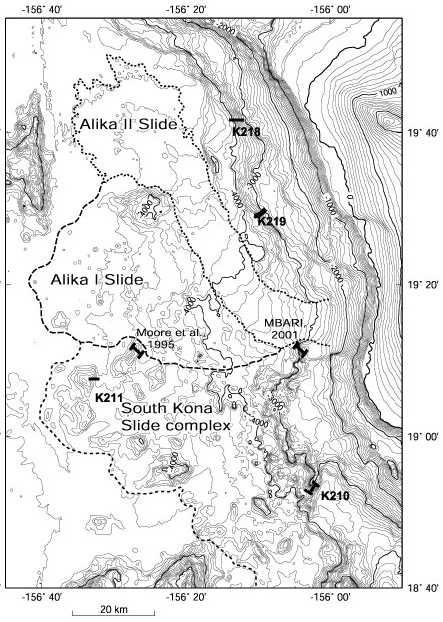2-9. North Kona bench complex Å@[P. Lipman]
Studies on the west (Mauna Loa-Hualalai)
side of Hawaii Island, where there are multiple
young landslide features (especially South
Kona. Alika, and North Kona), provide counterparts
to compare and contrast with the existing
detailed Hilina and Nu'uanu results. The
North Kona bench complex (Fig. 2-9-1), first
recognized by the USGS GLORIA side-scan surveys
(Lipman et al., 1988) and then in more detail
from SeaBeam bathymetry (Chadwick et al.,
1993) involves multiple geometrically intricate
proximal mid-slope benches and basins, and
a a distal region containing scattered small
blocks and hummocks(up to 1 km across and
100 m high). In contrast to the Hilina slump,
no extensional block fault structures are
preserved on land; any such faults originally
present may have been completely buried on
the steep slopes draped by young lavas between
the northwest rift zone of Hualalai and the
Kealakekua fault that roughly coincides with
the northem extent of lavas from Mauna Loa.
 (Fig. 2-9-1)
(Fig. 2-9-1)
The North Kona benches are likely entirely
related to Hualalai volcano: in addition
to the well defined northwest rift zone that
was active during the tholeiitic shield stage
of this volcano, a south rift zone has been
traced 10-15 kn south of the Kealakekua fault
by on-land gravity data (Kauahikaua and Hildenbrand,
2000), indicating that Hualalai extends well
to the south of its present surface exposures
(which are overlapped by Mauna Loa lavas
just north of the Kealakekua fault. Because
tholeiitic volcanism ceased at Hualalai at
>100 ka, it seems unlikely that lavas
from Mauna Loa will interfinger at deep ocean
depths of the lower North Kona benches. Although
Hualalai has been in the post-shield alkalic
stage for > 100,000 years, it continues
to erupt on average every few hundred years
(most recently in 1801) and is among the
potentially most hazardous of Hawaiian volcanoes
because of the substantial population living
on its slopes and the likely high flow velocities
likely from its low-viscosity alkalic lavas.
The large benches of the North Kona slump
have never been visually imaged, focus of
dive targets, or even sampled by dredging.
The deeper parts of several of them provide
exceptional places to search for lavas that
may extend our view of Hualalai magmatism
back in time. This would provide new views
on the evolution of the Hawaiian plume. Evidence
may also be obtained on the relative proportions
of pillow lava vs hyaloclastite involved
in construction of the submarine flanks of
large oceanic-island volcanoes, a current
topic of controversy. Several dives by the
Monterey Bay Aquarium Research Institute
(MBARI) were carried out in May 2001, just
south of the
Alika landslide that bounds the south side
of the North Kona slump, but no results are
yet available.
The lithologic sequence of lavas and volcaniclastic
rocks on the mid-slope benches, if studied
in detail, may provide critical information
on (1) the early growth of Hualalai, (2)
frequency of large submarine slumps from
another active Hawaiian volcano, (3) further
information on the relative role of extensional
slumping versus distal compression and uplift
in generating the submarine benches on the
offshore flanks of several Hawaiian volcanoes,
and (4) any possible involvement of rocks
from Mauna Loa volcano.
Year 2001 dive targets: The 2001 KAIKO dives were designed to provide
pilot information on the feasibility of such
studies. One dive (K218) was designed to
traverse a 900 m section up the steep lower
bench scarp downslope from the northwest
rift zone of Hualalai, and a second dive
(K219) to traverse a similar 800-m scarp
on a bench directly downslope from the summit
region of this volcano. The resulting video
images and in-places samples, when adequately
analyzed, should provide important information
on the primary volcanic sources (compositional
comparisons with young Hualalai lavas) and
eruption environment (subaerial vs. submarine).
Work plan: The new data on the North Kona terrain will
closely interface with the abundant existing
data and several in-progress studies on Hawaiian
volcanoes and with ongoing slope-stability
studies in Hawaii and elsewhere. Successful
interpretation of the stratigraphic, structural,
and petrologic complexities of the North
Kona area, for which questions still outnumber
answers, has critical implications for understanding
the primary depositional growth of the submarine
flanks of oceanic volcanic islands, and also
for structural evolution of Hualalai and
development of large slumps elsewhere in
the Hawaiian chain and on other oceanic islands.
Thorough study of the geologically young,
but seemingly inactive North Kona area should
perrnit instructive comparisons with the
new dive data on geometrically similar slump
and compressional structures at Hilina (Kilauea
volcano), South Kona (Mauna Loa), Laupahoehoe
(Kohala), and Waianae (Oahu) .
We will use submersible visual/video data
and marine seismic profiling data to interpret
the structure of the North Kona bench and
more distal slide blocks, and their relation
to volcano spreading along a basal detachrnent.
Samples will be analyzed chemically and petrographically
in order to determine compositions and eruption
depths of pillow lavas and the fragments
in volcaniclastic rocks. Analytical methods
will include major and minor elements for
bulk-rock samples by XRF and INAA methods,
glass compositions by electron-probe, and
ion-probe analysis, and volatile contents
by FTIR measurement. Radiogenic and stable
isotopic compositions of pillow-glass, glass-sand,
and whok~rock samples will be compared to
analogous data from other Hawaiian volcanoes.
Results could also permit informative comparisons
on the subaerial-submarine, and tholeiitic
alkalic transitions, especially with the
detailed data emerging from the Hawaii Scientific
Drilling Project for Mauna Kea. We will use
a combination of dating techniques, including
K-Ar, and 40Arl39Ar methods, to determine
the eruption ages of any high-K basalt samples.
A new piston core west of Hawaii Island (P13,
P14) will also test the important stratigraphic,
paleomagnetic, and
geochronologic correlations among basalt-glass
turbidites and permit comparisons with the
landslide record on the west flank of Hualalai.

 home
home 
(Fig. 2-9-1)